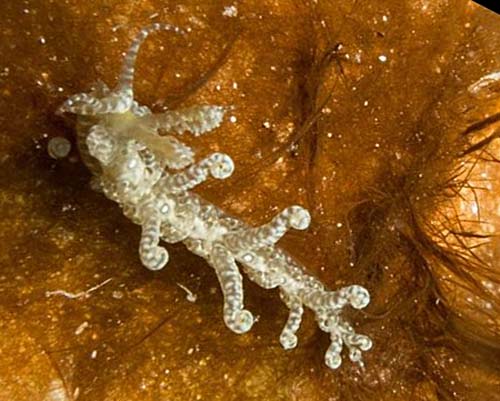This species has been observed on Reunion, Mauritius and Madagascar Islands
Species characteristics : Body colour is pale brown with large yellow spots over the dorsum The dorsal surface of the body from head to tail has series of concentric circles that are, from outside to inside, yellow, pale brown and white in the centre. The cerata are moderately long, fusiform and rounded. Some cerata are noticeably longer than the rest. Their tips are sharply recurved inwards. The cerata have the same colour as the body colour covered by yellow spots, with white cnidosacs. The rhinophores are ashy brown with small yellow spots. They are densely papillate on posterior side and the white apex is rounded. |

|
|
| Showing species characteristics... | Photo Sully Bachel Reunion, Ravine à Jacques, 9 m , 4 April 2010, size : 20 mm |
|
Remarks :
Identification confirmed by Hsini Lin
In our specimens the coloration of the yellow spots all over the body is very pale yellow rather than yellow...
Synonymous : (according worms)
- Baeolidia fusiformis Baba, 1949 (original combinaison)
Bibliographic data :
The body is thin and slender, tapering close to the tail. The anterior margin of the foot is rounded. The foot corners are tentaculiform and have a deep groove across width.
The number of the dorsal concentric circles depends on the size of the animal.
The papillae present on the posterior side of the rhinophores are elongate, not uniform in size, and occasionally bifurcated
The oral tentacles are elongate and longer than rhinophores
Both oral tentacles and foot corners are brownish with opaque yellow patches.
The cerata are arranged in up to fifteen rows, from just behind the rhinophores to the end of the foot, separated by a space. Each row contains 5–11 cerata, decreasing in size towards the foot
When crawling the innermost cerata in the most posterior row of each ceratal cluster waves around, that makes it appear to 'jerk' along.
See the very characteristic way (nudipixel) in which the large cerata closest to the midline are splayed out horizontally. The animal is not disturbed; this appearance is quite natural.
References :
Philippine sea slugs : Limenandra fusiformis
Bill Rudman Seaslug site : Sea Slug Forum : Limenandra fusiformis
Nudipixel Limenandra fusiformis
Publications :
Baba, K. (1949) Opisthobranchia of Sagami Bay . Iwanami Shoten, Tokyo. 211pp + pls.
Leila Carmona, Marta Pola, Terrence M. Gosliner, & Juan Lucas Cervera. 2013 . The end of a long controversy : systematics of the genus Limenandra (Mollusca: Nudibranchia: Aeolidiidae)
Other photos of Limenandra fusiformis :
Sully Bachel Reunion, Ravine à Jacques, 9 m , 4 April 2010, size : 20 mm
The cerata are moderately long, fusiform and rounded. Some cerata are noticeably longer than the rest. |
.jpg) |
.jpg) |
Yann von Arnim Mauritius, Mahebourg Marine farm, 22 m, 16 December 2015, size : 40 mm
The oral tentacles(a) are elongate and longer than rhinophores(b) |
Barbara Bini Madagascar, Nosy bé, 26 m, size : 20 mm This one is pretty odd !!! |
 |
More photos from Indian Ocean
If you have taken a photo of this species in Reunion, Mayotte or Mauritius Islands, please Contact us...